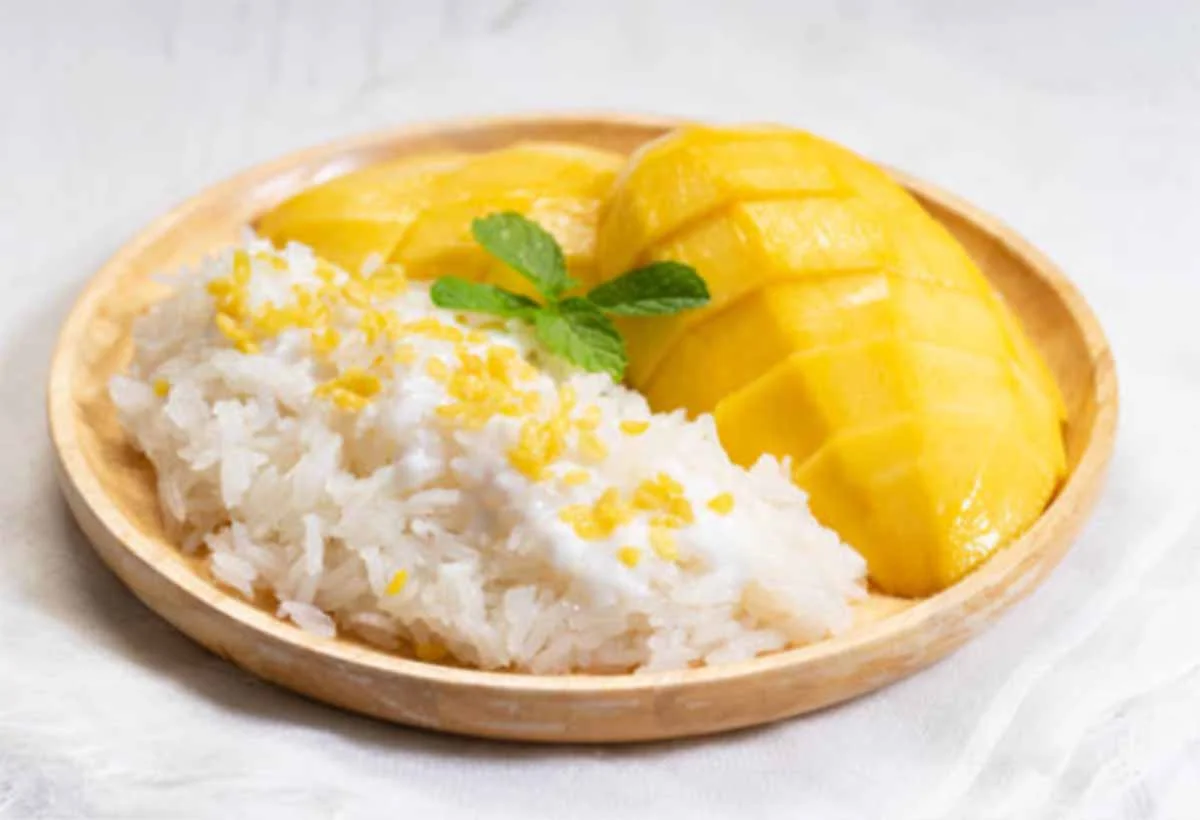Mango sticky rice is a popular Thai dessert that has gained popularity worldwide due to its unique combination of flavors. This dessert is made from glutinous rice, which is cooked in coconut milk and then topped with fresh mango slices. It is a simple yet satisfying dish that can be enjoyed any time of the year.
The origins of mango sticky rice can be traced back to Thailand, where it is a traditional dessert served during the mango season, which lasts from April to June. The dish has become so popular that it is now commonly served in Thai restaurants around the world. The combination of sweet and savory flavors, along with the creamy texture of the coconut milk and the soft, sticky rice, make this dessert a favorite among many.
Mango sticky rice is not only delicious but also nutritious. Glutinous rice is a good source of carbohydrates, while coconut milk provides healthy fats and essential nutrients. Mangoes are also rich in vitamins and antioxidants, making this dessert a healthy treat that can be enjoyed guilt-free.
Origin and History
Mango sticky rice is a traditional Thai dessert that has become increasingly popular around the world. The dish is made up of sticky rice, coconut milk, and ripe mangoes, and it is often served as a sweet and refreshing dessert.
The exact origin of mango sticky rice is unclear, but it is believed to have originated in Thailand. The dish has been a part of Thai cuisine for centuries and is often served at special occasions such as weddings and festivals.
Mango sticky rice was originally made using glutinous rice, which is a type of rice that is particularly sticky and chewy when cooked. The rice is soaked in water for several hours before being steamed and then mixed with coconut milk and sugar. The ripe mangoes are then sliced and arranged on top of the rice.
Over time, variations of the dish have emerged, with some chefs adding additional ingredients such as pandan leaves or sesame seeds to enhance the flavor. Mango sticky rice has also become popular in other parts of Southeast Asia, and it is now commonly found in Thai restaurants around the world.
Despite its popularity, mango sticky rice remains a traditional dish that is deeply rooted in Thai culture. It is a testament to the country’s rich culinary history and is a delicious and refreshing dessert that is enjoyed by people of all ages.
Ingredients and Varieties
Main Ingredients
Mango sticky rice is a popular Thai dessert that consists of sweet glutinous rice cooked in coconut milk and served with fresh mango slices. The main ingredients for this dish include glutinous rice, coconut milk, sugar, salt, and ripe mangoes.
Glutinous rice, also known as sticky rice, is a type of short-grain rice that becomes sticky and chewy when cooked. This type of rice is essential for making the dessert, as it gives the dish its signature texture.
Coconut milk is another key ingredient, as it provides a creamy and rich flavor to the rice. Sugar and salt are added to the coconut milk to enhance the sweetness and balance the flavors.
Regional Variations
While the basic recipe for mango sticky rice remains the same, there are several regional variations that incorporate different ingredients and flavors. In some regions, pandan leaves are added to the rice to give it a fragrant aroma.
In other regions, the rice is cooked with coconut cream instead of coconut milk, resulting in a richer and creamier texture. Some variations also include toppings such as sesame seeds, roasted peanuts, or coconut flakes for added texture and flavor.
Overall, mango sticky rice is a delicious and satisfying dessert that can be enjoyed in many different variations.
Culinary Preparation
Cooking Techniques
Mango sticky rice is a classic Thai dessert that is enjoyed around the world. The dish is made from glutinous rice, which is cooked in coconut milk and served with fresh mango slices. To make perfect mango sticky rice, it is important to use the right cooking techniques.
First, the rice should be soaked in water for at least 30 minutes before cooking. This helps to remove excess starch and ensures that the rice cooks evenly. After soaking, the rice should be drained and rinsed thoroughly.
Next, the rice is cooked in a mixture of coconut milk, sugar, and salt. The mixture is brought to a boil before the rice is added. The rice is then simmered over low heat until it is fully cooked and has absorbed all of the liquid.
Once the rice is cooked, it should be left to cool for a few minutes before serving. This helps to give the dish a sticky and chewy texture.
Serving Suggestions
Mango sticky rice is traditionally served in small bowls or plates. To serve, a generous portion of the rice is placed in the center of the bowl or plate. Fresh mango slices are then arranged on top of the rice.
For added flavor and texture, the dish can be garnished with toasted sesame seeds or shredded coconut. Some people also like to drizzle a little extra coconut milk over the top of the dish before serving.
Mango sticky rice is best enjoyed when it is fresh and warm. It can be served as a dessert or as a sweet snack. This dish is perfect for those who have a sweet tooth and enjoy the flavors of coconut and mango.
Cultural Significance
Mango sticky rice is not just a popular dessert in Thailand, but it also holds a significant cultural value. The dish is often served during special occasions, festivals, and celebrations, symbolizing the country’s rich culinary heritage.
Festivals and Celebrations
Mango sticky rice is a must-have dish during the Thai New Year festival, Songkran. The sweet and savory dessert is also served during the Loy Krathong festival, where Thais float banana leaf boats with candles and flowers on waterways to pay respect to the goddess of water.
Moreover, mango sticky rice is also a staple dish during weddings and other important celebrations. The dish is believed to bring good luck and prosperity to the newlyweds and their families.
Symbolism
Mango sticky rice is not just a dessert, but it also holds symbolic meaning in Thai culture. The dish symbolizes the harmony between the three main ingredients – rice, coconut milk, and mango. The rice represents the stability and foundation of Thai culture, while the coconut milk symbolizes the unity and strength of the Thai people. Lastly, the mango represents the sweetness and richness of Thai culture.
In addition, the dish also represents the importance of agriculture in Thai culture. Rice is a staple crop in Thailand, and the dish showcases the country’s agricultural wealth and the importance of rice in Thai cuisine.
Overall, mango sticky rice is more than just a dessert. It is a symbol of Thai culture, tradition, and values.
Nutritional Information
Mango sticky rice is a traditional Thai dessert that is popular all over the world. It is a sweet and creamy dish made with glutinous rice, coconut milk, and fresh mango. While it is a delicious treat, it is important to consider its nutritional value.
One cup of mango sticky rice (200 grams) contains approximately 285 calories, 5 grams of protein, 53 grams of carbohydrates, and 6 grams of fat. It also contains 2 grams of fiber and 23 grams of sugar. This makes it a high-calorie and high-sugar dessert that should be consumed in moderation.
The main ingredient in mango sticky rice is glutinous rice, which is high in carbohydrates and low in protein and fiber. Coconut milk, another key ingredient, is high in saturated fat and calories. However, it also contains medium-chain triglycerides (MCTs), which are a type of healthy fat that can help boost metabolism and improve brain function.
Fresh mango, the star of the dish, is a good source of vitamins and minerals. One cup of sliced mango (165 grams) contains approximately 99 calories, 1 gram of protein, 25 grams of carbohydrates, and 1 gram of fat. It is also high in vitamin C, vitamin A, and potassium.
Overall, mango sticky rice is a delicious dessert that should be enjoyed in moderation due to its high calorie and sugar content. However, it does contain some healthy nutrients, such as MCTs and vitamins, which can make it a better choice than other desserts.

